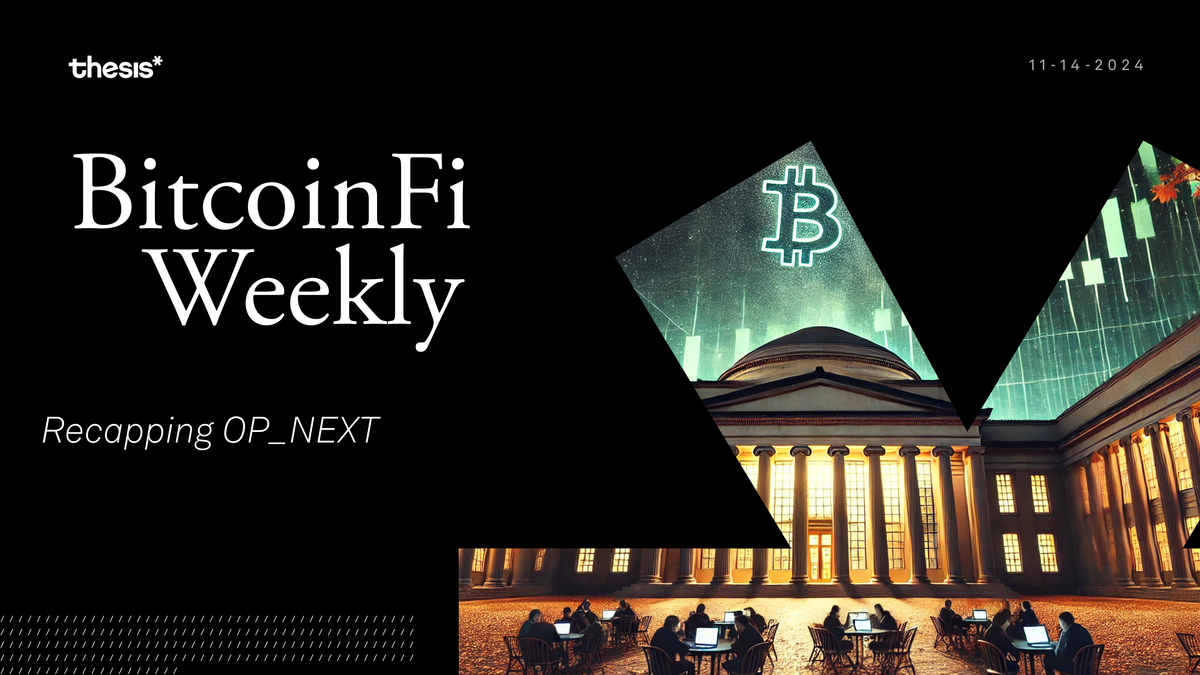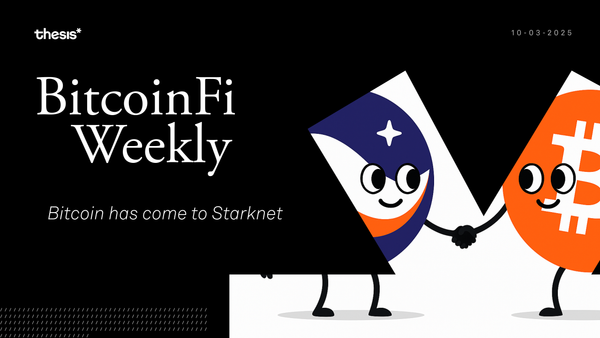Recapping OP_NEXT
Bitcoin hitting new all-time highs, massive inflows into Bitcoin ETFs, and new protocols emerging across ecosystems. It’s a moment of validation, a reminder that the fundamentals are stronger than ever.

Welcome to BitcoinFi Weekly. We cover where people use their BTC and what is changing in the Bitcoin world.
It’s been a brutal stretch, this bear market. Months on end where optimism felt like a relic, where headlines were grim, and the Bitcoin faithful kept their heads down, quietly weathering the storm. But as any survivor knows, bear markets don’t last forever. And here we are, finally, at what feels like the dawn of something bigger. Bitcoin hitting new all-time highs, massive inflows into Bitcoin ETFs, and new protocols emerging across ecosystems. It’s a moment of validation, a reminder that the fundamentals are stronger than ever. But it’s also a call to keep pushing, to build on what’s been achieved and prepare for what’s next. This week’s newsletter is a testament to that spirit. Let’s dive in.
Here’s this week’s rundown:
✨ Feature Piece: OP_NEXT Highlights
📈 BTF ETF Breaks Records
🏃 cbBTC TVL Catches Up with SolvBTC
🛠️ Ordinals Get an Update
🚀 Colend TGE
Feature Piece: OP_NEXT Highlights
In the heart of Boston, where autumn leaves scatter across MIT's historic grounds, something remarkable happened last week. After five long years since the last Scaling Bitcoin conference in Tel Aviv, the brightest minds in Bitcoin development gathered once again. Not for the glitz, not for the hype, but for something far more essential. This is OP_NEXT. No booths. No shills. No tokens. Just pure, unadulterated Bitcoin scaling discussions in their natural habitat.
The Stakeholders' Dance
Steve Lee and Ren kicked things off with what might be the most sobering reality check the Bitcoin community has faced in years. Their analysis of Bitcoin's consensus mechanism reads like a detailed map of power dynamics in a complex ecosystem. Bitcoin, they argue, is deliberately difficult to change – and that's by design. The default state is stasis, and any significant change must climb a mountain of resistance.
They've identified six distinct stakeholder groups, each playing their part in this intricate dance of consensus. Perhaps most notably, while Bitcoin Core maintainers don't have the power to unilaterally change Bitcoin, they do wield significant veto power. It's a subtle but crucial distinction that shapes the entire landscape of Bitcoin development.
The Art of the Soft Fork
PortlandHODL delivered what could be called a master class in Bitcoin's evolution mechanisms. Bry breaking down the three types of soft forks—security/network operation, feature activations, and improvements—he painted a picture of Bitcoin's technical heritage that few have articulated so clearly.
Walking us through how Bitcoin has only seen seven formal soft fork activations in its history, five of which came before SegWit in 2017. The analysis highlighted the unintended consequences of past soft forks, using SegWit as a case study. SegWit inadvertently created a transaction hierarchy where economic transactions pay higher fees for blockspace than arbitrary data transactions. This observation feeds into Portland's argument for the Great Consensus Cleanup, which he positions as the most pressing soft fork need. Looking forward, he identified critical issues requiring future soft forks: the timestamp bug, quantum computing resistance, and scaling improvements.
Defining Layer 2s
Peter Todd's analysis of Bitcoin Layer 2s cut through the noise like a hot knife through butter. He establishes precise technical criteria for true Layer 2s, differentiating them from centralized services. A genuine Layer 2 must contain conglomerated transactions with reactive security, enabling unilateral withdrawals without counterparty trust. Simple, elegant, and precise.
In a moment of characteristic directness, Todd dismissed Liquid, Cashu, and Statechains as "fancy banks" rather than true Layer 2s.
His analysis of Lightning Network limitations revealed that even using 90% of block space for channel opening would only support 1.1 billion channels annually. Channel factories utilizing virtual UTXOs offer potential scaling improvements, with ArkLabs leading development in this direction. Todd's examination of rollups emphasized their role in scaling, while maintaining that covenant implementation could unlock more efficient Layer 2 architectures.
The OP Chronicles
The discussion of covenants brought out some of the most passionate debates of the conference. Jeremy Rubin's reflection on the journey of CTV (CheckTemplateVerify) reads like a technical thriller – from its conception in 2017 to its current state of limbo.
The opposition he faced, the technical challenges, the political maneuvering – it's all part of the messy, necessary process of Bitcoin evolution.
Specifically, opposition centered on activation timing relative to Taproot and broader covenant implications. The proposal stalled despite code readiness, highlighting the complexity of Bitcoin's consensus change process. Current covenant alternatives include BitVM (complex but trustless), FE'd Up Covenants (simpler but trust-dependent), and ColliderScript (resource-intensive).
Ethan Heilman's presentation on OP_CAT added another layer to the covenant conversation. This simple opcode, originally part of Bitcoin but removed in 2010, could enable everything from vaults to general computation. OP_CAT's proposed reactivation would concatenate stack elements in Tapscript, using OP_SUCCESS for soft fork activation. The technical specification maintains compatibility with the original opcode while adding modern safeguards. BIP-347 outlines implementation details for enabling vaults, general computation, and specific covenant types.
Heilman's analysis reveals that while CAT enables covenant functionality, its implementation would be distinct from dedicated covenant opcodes like CTV. The technical design allows stack element interaction previously impossible in Bitcoin Script, though resulting covenant constructions remain complex and resource-intensive.
Rijndael took a more pragmatic angle, discussing the developer tools that could make these changes practical. He argued that if Bitcoin can embrace covenants, it’s time to remove the incidental complexities – the bits of technical clutter that have bogged down its script over the years. His team’s tool, Catana, might be the answer, designed to eliminate the technical noise and let developers focus on the problems that matter.
Looking Forward
Finally, Paul Sztorc closed out with a view to the future: a core-untouched soft fork, a wild concept that would sidestep the behemoth that is Bitcoin Core. Instead, Sztorc proposed using an auxiliary software layer to enable upgrades without touching Core at all. If ordinals and inscriptions taught us anything, it’s that Bitcoin’s ecosystem is ready for more experimentation. Sztorc’s pitch is that a second-layer protocol could bring scalability to Bitcoin without forcing every developer to work within Core’s rigid, slow-moving framework. Sztorc's CUSF proposal responds to Bitcoin's historical fee revenue trajectory, projecting potential $640 billion annual fees at global adoption scale. Technical implementation would maintain Bitcoin Core's consensus rules while enabling parallel rule sets for advanced functionality.
In the end, OP_NEXT left us with more questions than answers, a sign of any good conference. But there was an underlying consensus, a shared understanding that while Bitcoin remains the bedrock of decentralized finance, the pressure to grow and evolve is real. Folks don’t want to transform Bitcoin into something it isn’t, but rather, preserve its values while preparing it to bear the weight of a world that’s getting a little heavier every day. The reunion of gigabrains in Boston reminded us all that if Bitcoin is to scale, it’s going to need both tradition and a touch of rebellion.
BitcoinFi Updates
BTF ETF Breaks Records
This week in Bitcoin was one for the history books. BTC price soared, setting a new all-time high, and with it came a tidal wave of institutional investment. The Bitcoin ETF frenzy has officially been reinvigorated, with $IBIT leading the charge. In just a single day, $IBIT saw $5 billion in volume, marking the highest trading day for the fund to date.
$FBTC saw its biggest day since March, hitting $1 billion in volume. The broader Bitcoin Industrial Complex - encompassing ETFs, mining stocks, and related equities - has generated approximately $110 billion in weekly volume, establishing an all-time record with two trading days remaining.
But the star of the show remains BlackRock’s Bitcoin ETF, which has amassed a staggering $40 billion in assets in record time, making it the most successful ETF launch ever. It’s a landmark achievement and one that signals a seismic shift in Bitcoin’s journey toward mainstream financial adoption. For all the volatility and all the questions, Bitcoin’s long game seems to be taking shape, led by institutional demand that’s no longer tiptoeing in but diving deep.
cbBTC TVL Catches up with SolvBTC
TVL on Coinbase’s cbBTC rapidly catches up to Solv’s SolvBTC, roughly tying for the third-largest wrapped Bitcoin asset. Only BitGo’s WBTC and Binance’s BTCB surpass it. The underlying reason? Staking dynamics and the growing popularity of liquid staking tokens (LSTs) are changing the landscape.
While surface-level metrics show parity between cbBTC and SolvBTC, the complete picture reveals Solv's total reserve exceeds 25,000 BTC. This discrepancy emerges from Solv's approach to Bitcoin LSTs, particularly through their integration with Babylon Protocol.
The effect has been notable. As more users stake their SolvBTC for LSTs, the supply of SolvBTC decreases, which has given cbBTC a boost in total supply, temporarily surpassing SolvBTC. This shift is indicative of the demand for staking options that can offer yield and points.
Ordinals Get an Update
TLDR: Ordinals just got a major upgrade with ord 0.21.3, adding features like BIP322 message signing for ownership proof, improved tracking by address, and easier UTXO management—all of which make managing and verifying inscriptions smoother and more secure.
Ordinals just got a bit sharper and a bit more refined with the release of ord 0.21.3. The addition of BIP322 sign file functionality marks a crucial step toward standardized message signing for ordinals. This implementation enables marketplaces to verify inscription ownership through Bitcoin's native message signing protocol, potentially reducing fraud risks and improving marketplace security. The technical significance establishes a framework for standardized ownership proof across the ordinal ecosystem.
The address-based output information feature improves ordinal tracking by allowing users to view UTXO details associated with specific addresses. This includes basic information on output status and transaction history, reducing reliance on external block explorers for some tracking needs.
The ord wallet split command provides users with more precise UTXO management within the ord client. It enables splitting UTXOs while handling denomination sizing and fee estimation in a streamlined way, supporting users who want to organize their UTXOs effectively. The feature is compatible with taproot, which helps maintain compatibility with ordinal indexing systems.These features could benefit traders and market participants by providing greater control over UTXO configurations, potentially simplifying workflows that previously required multiple tools.This update reduces operational complexity for ordinal management while offering users more control over UTXO organization within the ord client.
Colend TGE
Colend has established itself as the dominant lending protocol within Core's ecosystem, securing over $250 million in TVL. Its position as the primary lending/borrowing platform mirrors Aave's role in traditional DeFi. The protocol ranks first among Core lending platforms and second overall in the Core ecosystem according to DeFiLlama metrics. Now listed across several major exchanges, Core is following in the footsteps of TON, and Colend’s TGE is kick-starting a new phase for the sidechain.

Closing Thoughts
And so we find ourselves here, dear reader, at the crossroads of triumph and trepidation. The same Bitcoin that was once cast out, condemned as the devil's money by those who worship at the altar of traditional finance, now stands vindicated - not through revolution or violence, but through the quiet persistence of its disciples. This week's milestones—OP_NEXT’s intellectual revival, ETF records, the steadfast ascent of Core’s ecosystem—remind us that Bitcoin’s journey is as much an odyssey of spirit as it is of technology. We are in the midst of its transformation, an evolution of purpose and direction, where every step forward demands resilience, insight, and sometimes, faith.
Thank you for tuning in to this week’s BitcoinFi Weekly. See you next week.
If there's a topic you’d like us to cover or have questions, reach out at [email protected].
Learn more about Mezo at the following channels:
👾 Discord: https://discord.mezo.org
🕊 X: https://twitter.com/MezoNetwork
🖥 Website: https://mezo.org
🏦 Deposit Portal: https://mezo.org/hodl
ℹ️ Docs: https://info.mezo.org





